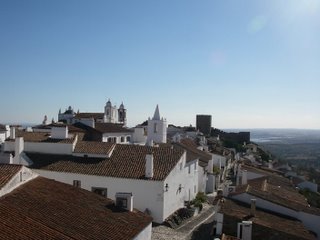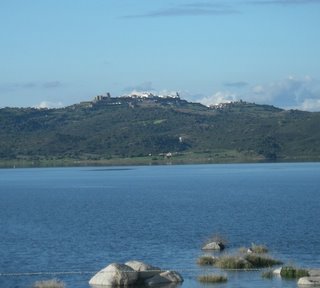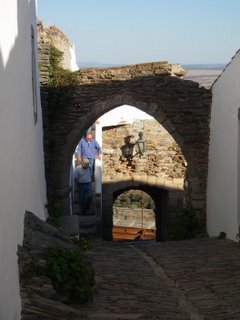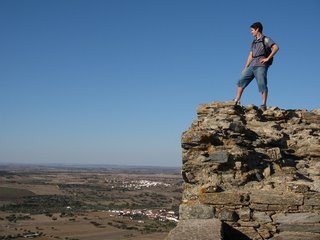Monsaraz
If anyones actually tried to follow the timeline of this blog they would've been lost in the last couple of months due to the backlog from Mum and Dad's visit, Andrew's visit and all the things I keep posting week-in, week-out. This post has a certain syncronisity to it - I visited Monsaraz with Andrew but was driving out this way today hence the motivation to post. Monsaraz is THE hilltop castle town, the jewel of the Alentejo. It has been kept in pristine condition since it was fortified in the 14th Century despite being on the edge overlooking the Spanish border. I'm guessing one of the reasons it's remained untouched that the village was given to the Knights Templar in the 12th Century and most people didn't mess with those guys, walls or no walls.
Monsaraz is THE hilltop castle town, the jewel of the Alentejo. It has been kept in pristine condition since it was fortified in the 14th Century despite being on the edge overlooking the Spanish border. I'm guessing one of the reasons it's remained untouched that the village was given to the Knights Templar in the 12th Century and most people didn't mess with those guys, walls or no walls. Another reason for Monsaraz's preservation was the presence of Mourao on the other side of the Rio Guardiana (the historic border) with a much larger castle. This river was dammed in the last 20 years meaning a lake now seperates Monsaraz and Mourao (and Spain) allowing for much prettier photos.
Another reason for Monsaraz's preservation was the presence of Mourao on the other side of the Rio Guardiana (the historic border) with a much larger castle. This river was dammed in the last 20 years meaning a lake now seperates Monsaraz and Mourao (and Spain) allowing for much prettier photos. The village inside the walls is a window back to medieval Portugal, cobbled streets and stone walls, tiny whitewashed houses where even the modern Portuguese hit their heads (let alone us 6ft Aussies). The town also shuts down at 7pm so the advice in Lonely Planet is to eat early. Somehow its not surprising to see a horse ridden down the streets in front of you.
The village inside the walls is a window back to medieval Portugal, cobbled streets and stone walls, tiny whitewashed houses where even the modern Portuguese hit their heads (let alone us 6ft Aussies). The town also shuts down at 7pm so the advice in Lonely Planet is to eat early. Somehow its not surprising to see a horse ridden down the streets in front of you. The parade ground in the castle at Monsaraz has been converted into an amphitheatre for concerts and bullfights. But everytime I've heard about a bullfight here the news has said it was illegal - I'm not sure how you have an illegal bullfight if you've announced it on the news the week before?! Like Mourao the amount of access around the castle is unbelievable if you come from the more restrictive societies where you can't climb up and down ramparts and battlements. At Monsaraz you can also get into the ring so I showed off my best bull imitation to a confused crowd of Spanish and Portuguese daytrippers.
The parade ground in the castle at Monsaraz has been converted into an amphitheatre for concerts and bullfights. But everytime I've heard about a bullfight here the news has said it was illegal - I'm not sure how you have an illegal bullfight if you've announced it on the news the week before?! Like Mourao the amount of access around the castle is unbelievable if you come from the more restrictive societies where you can't climb up and down ramparts and battlements. At Monsaraz you can also get into the ring so I showed off my best bull imitation to a confused crowd of Spanish and Portuguese daytrippers. Since the village is relatively small and the hill doesn't leave much room for expansion it was never developed in the 17th-18th century or more modern times unlike other hilltop towns in the Alentejo. Instead the moderns towns were built on the plains below as seen in this photo (where Andrew is looking down on all the little people below).
Since the village is relatively small and the hill doesn't leave much room for expansion it was never developed in the 17th-18th century or more modern times unlike other hilltop towns in the Alentejo. Instead the moderns towns were built on the plains below as seen in this photo (where Andrew is looking down on all the little people below).

No comments:
Post a Comment